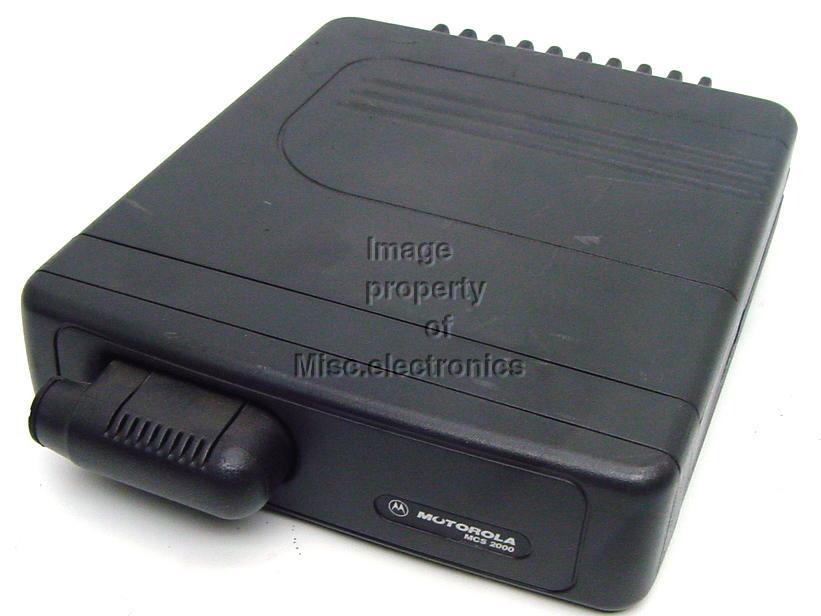Environmentally Conscious and Economically Sound Machine Dismantling Forum > Milwaukee
> Tips and Advices
> Forum Tips
> Motorola MCS2000 uhf digital digital repeater mcs 2000
Motorola MCS2000 uhf digital digital repeater mcs 2000
The MCS2000 is a mobile radio system component which provides on-site repeater capability between a portable radio and a base station. The MCS2000 gives the portable user the equivalent range of a mobile radio with the flexibility of a portable. The MCS2000 is designed to interface with an ASTRO mobile radio, however it can only transmit and receive clear analog transmissions.
The MCS2000 supports the ASTRO Spectra mobile with a Remote Control head type of W4, W5, W7, or W9. The ASTRO Spectra mobile frequency band must be different than that of the MCS2000, as the MCS2000 supports Cross Band Operation. Analog, IMBE/CAI, and 9600 baud Trunking signaling types are supported but VSELP is not.
Programmable Frequency and Channel Spacing: These MCS2000 parameters can be programmed using ASTRO mobile CPS.
Automatic Multiple Unit Priority Algorithm: Each MCS2000 will monitor for other MCS units in the area the result is one single priority unit for each scene. Portable Priority Interrupt: The MCS2000 will monitor for portable activity to allow both trunking access and priority portable communications.
Repeater Access PL: This feature only allows portables with the correct matching PL frequency to access the MCS2000. It can be programmed to any of the standard PL Code frequencies.
Mobile Mode Steering: This feature allows the portable operator the ability to select the mobile mode on which messages will be transmitted and received. This is done via PL tones. The operator may program as many as eight such tones, along with the corresponding mobile mode numbers, in the MCS2000. The portable operator sets the portable channel switch to the position corresponding to the desired mobile mode and keys up the portable. The MCS2000 automatically steers the mobile to the desired mode. In addition, one of the PL modes can be programmed as selected mode, allowing the portable user to transmit on the mobile mode last selected via the mobile control unit within the vehicle.
Emergency Activation: The portable and MCS2000 can be programmed so that the user can generate an emergency alert from the portable. The MCS2000 detects the emergency and activates emergency in the mobile. The mobile will enter emergency just as if the emergency button had been pressed on the mobile control unit.
Transmitter PL: The transmitter PL generator causes the MCS2000 to repeat base-to-portable with a specific field-programmable PL tone. The user can monitor the mobile channel via his portable and still have PL protected audio.
In-Car-Monitor: The MCS2000 can be programmed to allow a person inside the vehicle to communicate with the dispatcher and portable users at the same time (BOTH) or to the dispatcher only (BASE). When BOTH communications is selected, the person inside the vehicle can also monitor any voice activity.
Access Acknowledgement and Mobile Time Out Timer (TOT) Tones: To give the portable user assurance that the MCS2000 has received his transmission and repeated it over the mobile, two tones are sent back to him. A high-pitched tone is sent if the message was repeated over the mobile. A low-pitched tone is sent if the message was cut short due to TOT being exceeded. In addition, trunking tones are also passed to the portable.
Time-Out Timer: A built-in time-out timer feature is standard and may be set to 30, 60, or 120 seconds. The timer prevents prolonged system tie-up. Should the timer turn off the MCS2000 repeater, the logic circuit automatically removes the repeater from the priority state, allowing another unit in the system to assume the repeat function.
Flashing Display: The ASTRO mobile can be programmed to alternate the display between the mode display and the VRS in-car-monitor state ( VRS BOTH or VRS BASE ) when the MCS is activated.
